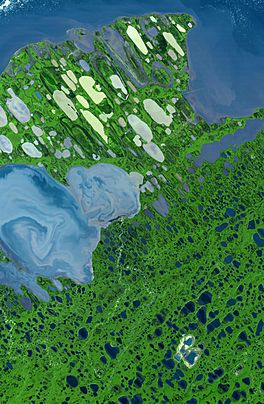Teshekpuk Lake facts for kids
Quick facts for kids Teshekpuk Lake |
|
|---|---|

False-color image of Teshekpuk Lake (on left side of image) and the North Slope. Green indicates vegetation and blue indicates water. Some bodies of water also appear in off-white or yellowish, probably due to different amounts of sediment in the water and/or the sun angle. The Beaufort Sea is at the top of the scene.
|
|
| Lua error in Module:Location_map at line 420: attempt to index field 'wikibase' (a nil value). | |
| Location | North Slope Borough, Alaska |
| Native name | Tasiqpak Error {{native name checker}}: parameter value is malformed (help) |
| Basin countries | United States |
| Max. width | 22 mi (35 km) |
| Surface area | 320 square miles (830 km2) |
| Surface elevation | 7 ft (2.1 m) |
Teshekpuk Lake, known as Tasiqpak in the Iñupiaq language, is a very large lake in Alaska. It is about 22 miles (35 km) wide. You can find it on the Arctic Ocean coast, near Pitt Point. It's an important natural area in the Arctic.
Contents
What's in a Name? Teshekpuk Lake's Meaning
The name Teshekpuk comes from the Iñupiaq language. The original word is Tasiqpak. This name means "big lagoon" or "big coastal lake."
Other names for this lake include:
- Lake Teshekpuk
- Tasekpuk Lake
- Tasirkpuk Lake
- Tasyukpun
Exploring the Teshekpuk Lake Environment
Teshekpuk Lake is the biggest lake in Arctic Alaska. It is also the largest thermokarst lake in the world. A thermokarst lake forms when ice in the ground melts, creating a depression that fills with water.
Amazing Wildlife: Fish, Caribou, and Birds
Many types of fish live in Teshekpuk Lake. These include broad whitefish, Arctic grayling, and burbot. You can also find Arctic cisco, lake trout, and Dolly Varden here. Chinook salmon and chum salmon also swim in its waters.
The area around the lake is home to lots of Arctic animals. The Teshekpuk Lake Caribou Herd, with about 64,000 animals, lives here. Many shorebirds and migratory waterfowl also use this region. They come to feed and raise their young.
Studying Climate Change at Teshekpuk Lake
Scientists study the Arctic environment at the Teshekpuk Lake Observatory. This research center was set up by the U.S. Geological Survey and other groups. They want to understand how climate change is affecting the Arctic.
Protecting the Coast: Erosion Challenges
In 2007, a study showed a big problem near Teshekpuk Lake. The sea ice is disappearing quickly. This causes the land to erode, or wear away, very fast. In some places, the sea has moved inland by half a mile.
When the sea pushes in, salt water mixes with the freshwater lakes. This harms the habitats for birds and caribou. It also damages buildings and roads along the coast.
Experts say Teshekpuk Lake is one of the most important places in the entire Arctic. It is especially vital for geese. Many geese come here to molt, which means they shed their old feathers and grow new ones.

